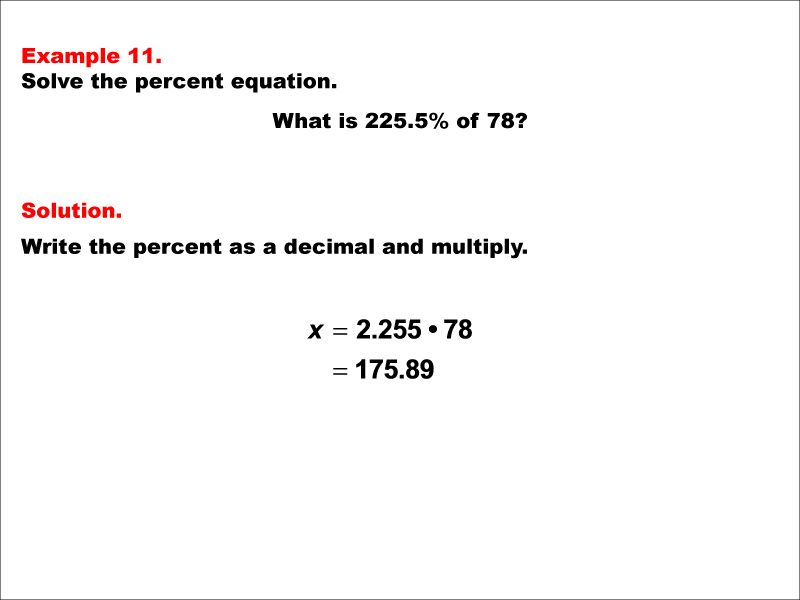
Display Title
Math Example--Percents--Equations with Percents: Example 11
Display Title
Math Example--Percents--Equations with Percents: Example 11

Topic
Solving Equations
Description
This math example focuses on solving percent equations, specifically asking "What is 225.5% of 78?" The solution involves converting 225.5% to its decimal form, 2.255, and then multiplying it by 78 to arrive at the answer of 175.89. This example introduces a decimal percentage greater than 200% and a larger whole number as the base value, demonstrating the scalability and flexibility of the percent-to-decimal conversion method in complex scenarios.
Solving equations with percents is a critical skill in mathematics that finds applications in various fields such as finance, statistics, and scientific research. These examples help students grasp the fundamental concept of converting percentages to decimals and applying them to different numbers, even when dealing with percentages well above 100%. This understanding forms the basis for more complex mathematical operations and real-world problem-solving scenarios, such as calculating compound growth rates, analyzing market trends, or understanding exponential increases in scientific phenomena.
Providing multiple worked-out examples is essential for students to fully comprehend this concept. Each new example reinforces the process while introducing different percentage values and base numbers. This approach allows students to recognize patterns, adapt their problem-solving strategies, and build confidence in handling diverse percentage-based calculations, preparing them for more advanced mathematical challenges they may encounter in higher education or professional settings. By practicing with a wide range of percentages, including those above 200%, students develop a more nuanced understanding of how percentages relate to real-world quantities.
Teacher Script: "Let's look at our next example. We need to find 225.5% of 78. What's our first step? Right, we convert the percentage to a decimal. So, 225.5% becomes 2.255. Now, we multiply this by our base number, 78. Can anyone tell me what 2.255 × 78 equals? Great job, it's 175.89. Notice how we're using the same method, but with a decimal percentage greater than 200% this time. This shows that our approach works consistently, regardless of the size or complexity of the percentage. In real-life situations, you might encounter scenarios where something more than doubles or triples, represented by percentages over 200% or 300%. Being comfortable with these calculations will help you analyze and understand complex growth or increase scenarios in various fields."
For a complete collection of math examples related to Solving Equations click on this link: Math Examples: Equations with Percents Collection.
| Common Core Standards | CCSS.MATH.CONTENT.6.EE.B.5, CCSS.MATH.CONTENT.7.RP.A.3, CCSS.MATH.CONTENT.6.RP.A.3.C |
|---|---|
| Grade Range | 5 - 8 |
| Curriculum Nodes |
Algebra • Expressions, Equations, and Inequalities • Solving Percent Equations |
| Copyright Year | 2013 |
| Keywords | Percent, equation, solution, solving equation, percentage |